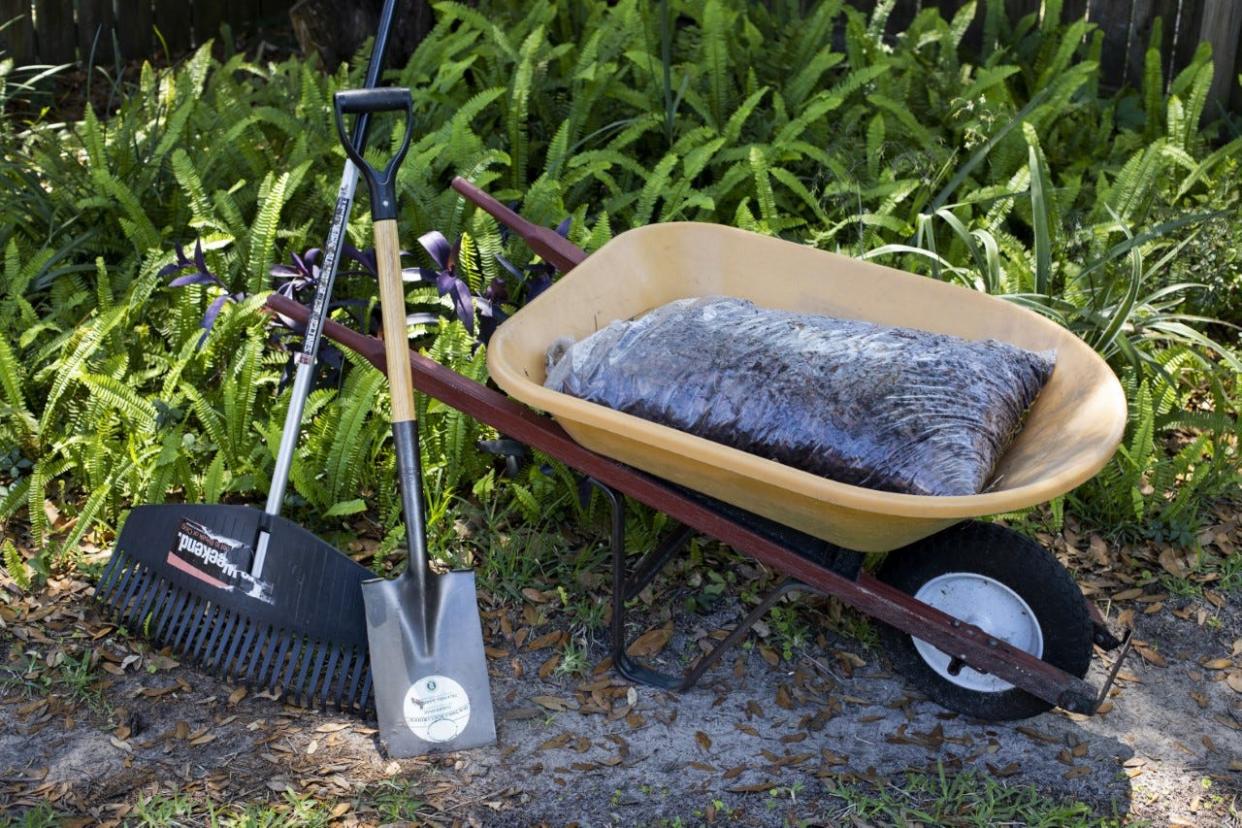Garden Q&A: Adding mulch to the soil has multiple benefits

Two garden terms you might often see mentioned in these columns are “compost” (decaying organic matter) to enrich our sandy soil and “mulch” (material spread around plants to reduce evaporation, enrich the soil and reduce weeds). If they sound like the definitions overlap, they do.
There are many organic mulches that are popular, from pine bark and cypress bark to fallen leaves and pine straw. Some people also use gravel or stones or shredded rubber. These last three are not organic and they aren’t going to break down and add nutrients to your soil.
Mulch has several purposes. Reducing evaporation and steadying the soil temperatures are important here, and we can be especially aware of it at this time of the year as we watch our temperatures go from very chilly to very warm in the matter of a few hours. The same will be true later in the year, when temperatures go to blazing hot during the day. It’s much healthier for the plants to have their roots sheltered from that temperature change and moisture level changes with a 2- to 3-inch layer of mulch.
Natural materials like bark, leaves and pine needles are able to help control temperatures and moisture level changes. Gravel and stones not only cannot help reducing temperatures, they absorb the heat and reflect it back up onto the plants as well. Rock mulches are not recommended for our area because they increase the amount of heat during the spring heat waves and summer, making conditions more difficult for plants. They actually increase the heat in the area around the plants — and that means for you and me too.
A layer of mulch can also help prevent weed seeds from making contact with the soil and help prevent them from being able to germinate. If weed seeds are under the mulch, covering it with mulch prevents it from getting sunlight and therefore germinating. That saves the gardener from pulling those weeds out later. Any weeds that germinate on the surface of the mulch tend to not root deeply and are more easily pulled. (Gardener win!)
Cypress mulch has long been a popular mulch. It is fair to say that we have loved cypress trees to death. The great value of cypress has been that the wood in mature trees contain many wonderful qualities. The mature trees contained a chemical that repelled insects called thujon. And yes, cypress mulch also smells good.
The problem is that those mature trees are gone now. They have been harvested and used, and it will be a long time before we see stands of mature cypress trees again. Young trees do not contain the same insect repellent. So, we don’t have that reason for buying cypress mulch.
At this point the University of Florida does not recommend using cypress mulch in your yard. It clumps together. It dries out and forms a mat, preventing water from reaching your plant roots. Perhaps more importantly, it is not environmentally sustainable to harvest cypress forests simply for mulch. If we don’t stop using cypress trees for mulch, we may lose our mature cypress forests.
Pine trees grow rapidly and produce good mulch. You can buy pine bark mulch in several “chunk” sizes from mini to large sizes. They stay in place. Around annual flowers, I prefer to use pine straw because it is much easier on their stems when the wind blows.
Some people also use melaleuca mulch or eucalyptus mulch. It makes sense to recycle the plants that way, but it can be a problem for people with respiratory allergies.
Keep the mulch away from the base of your plants; you want to keep your plant base dry. A few inches of distance is fine.
Whatever you use, mulch! It will break down, but as it does, it will be enriching your soil, so you will benefit while it is mulch and benefit again when it decomposes. Replenish and begin the process again.
• • •

On another note: I was visiting my family and captured a great big invasive Cuban tree frog (as big as my fist), popping it into a plastic bag and into a deep freeze for disposal. My granddaughter challenged me, asking why this frog needed to die.
This was one of those times that a standard University of Florida answer wasn’t going to fly. She already knows I don’t go around killing animals casually, so I guess I surprised her with my quick and absolute resolve to get rid of this amphibian when I love the native green tree frogs. But invasive species like the Cuban tree frog have voracious appetites and devour native tree frogs and other animals at a tremendous rate.
They breed rapidly and have few effective checks and balances on their populations, which they would have in their native countries.

And all of our native species are already under pressure from our warming climate. They don’t need the extra pressure from invasive species gobbling up the local resources too.
As a Master Gardener volunteer with the University of Florida (and a grandmother), one of the things I get to do is to spread the word how invasive species impact Florida’s natural areas and the roles residents can play to help mitigate their impacts. This includes picking up the air potato, getting rid of the Cuban tree frog, and removing the Brazilian pepper plant and Chinese tallow tree when you can. Even when it includes having difficult discussions with my granddaughter. You should play a part too.
Becky Wern is a Master Gardener Volunteer with the Duval County Extension Service and the University of Florida/IFAS. For gardening questions, call the Duval County Extension Office at (904) 255-7450 from 9 a.m. to noon and 12:30 to 3:30 p.m. Monday-Friday and ask for a Master Gardener Volunteer.
This article originally appeared on Florida Times-Union: Garden Q&A: Adding mulch to the soil has multiple benefits

